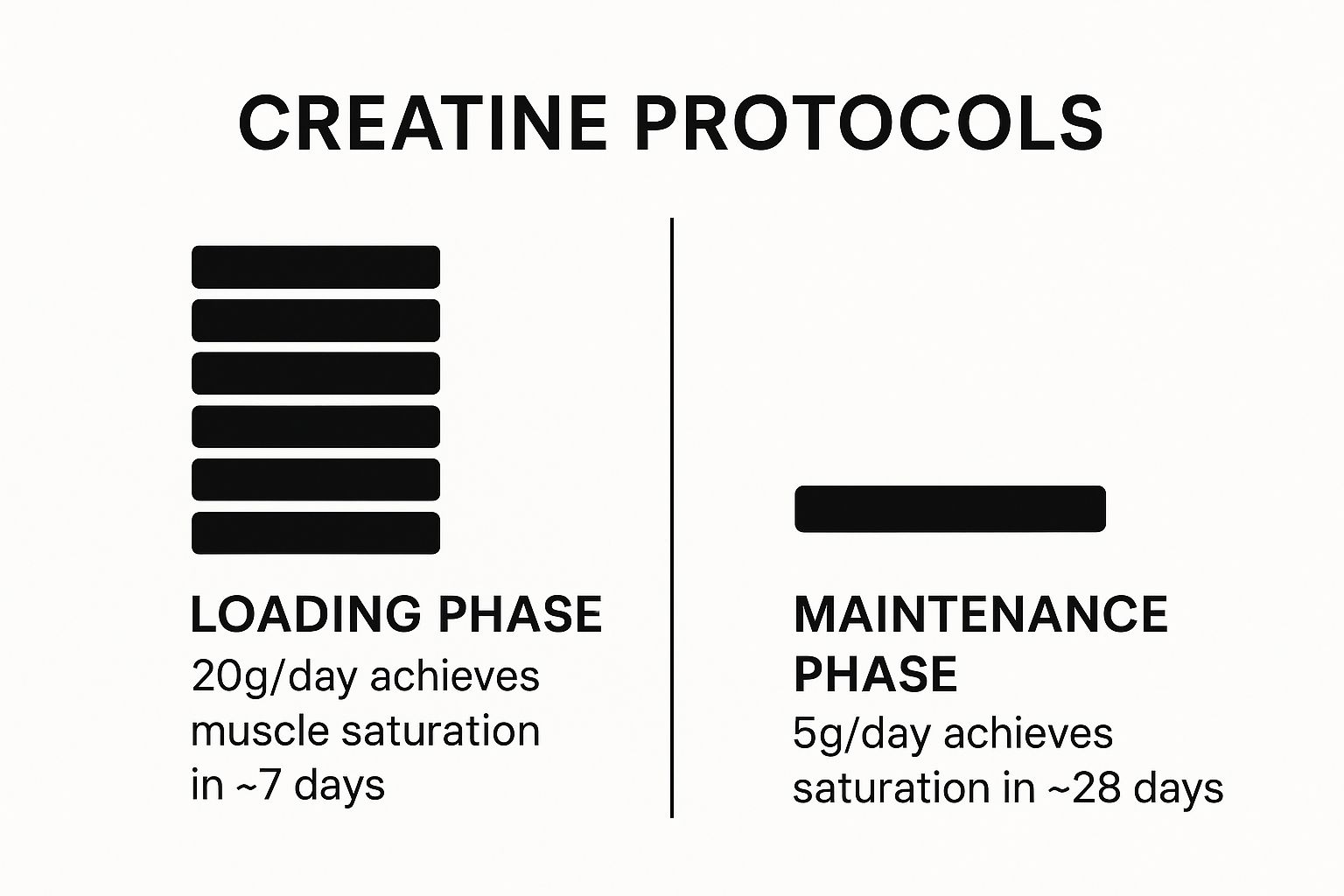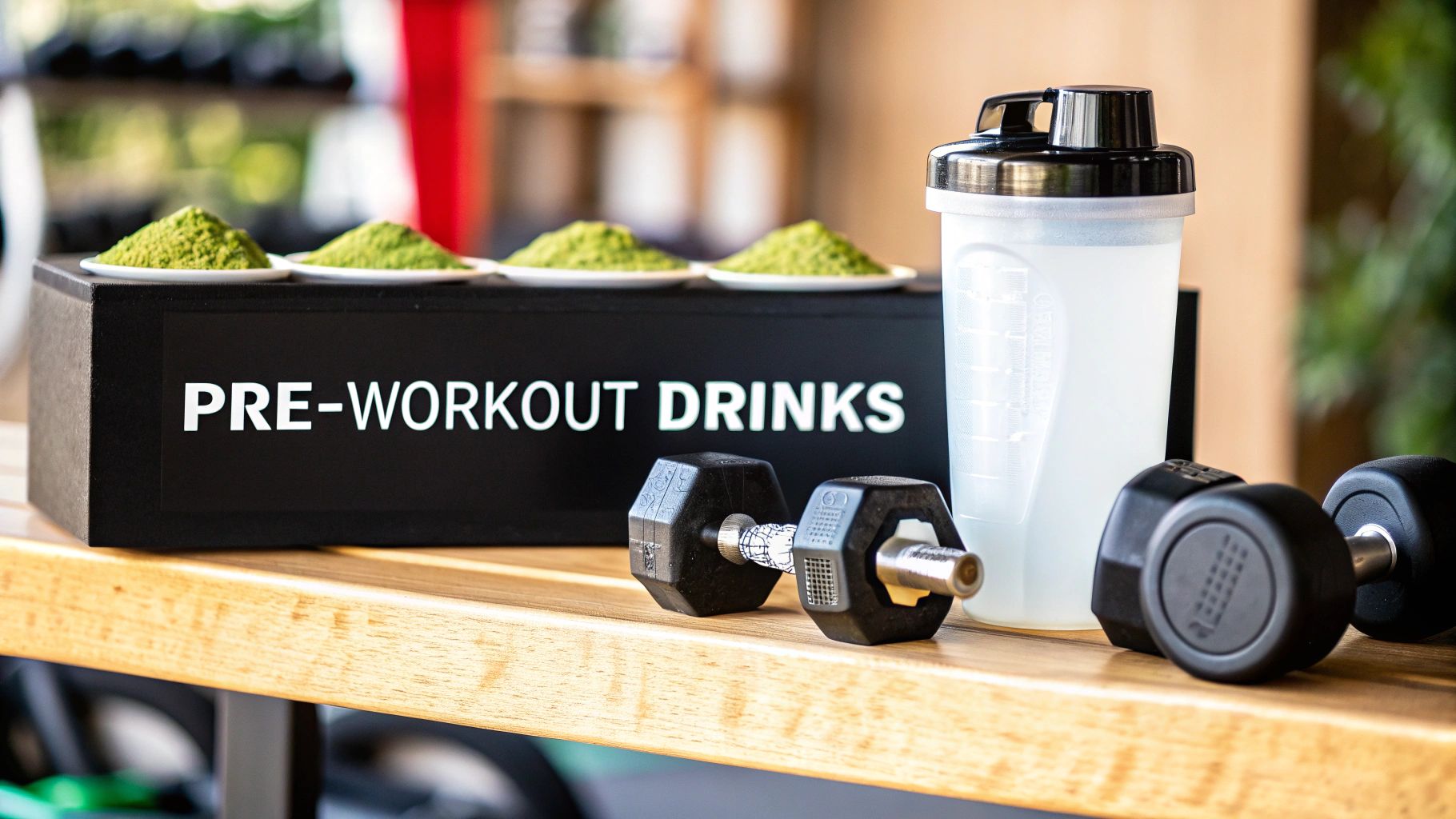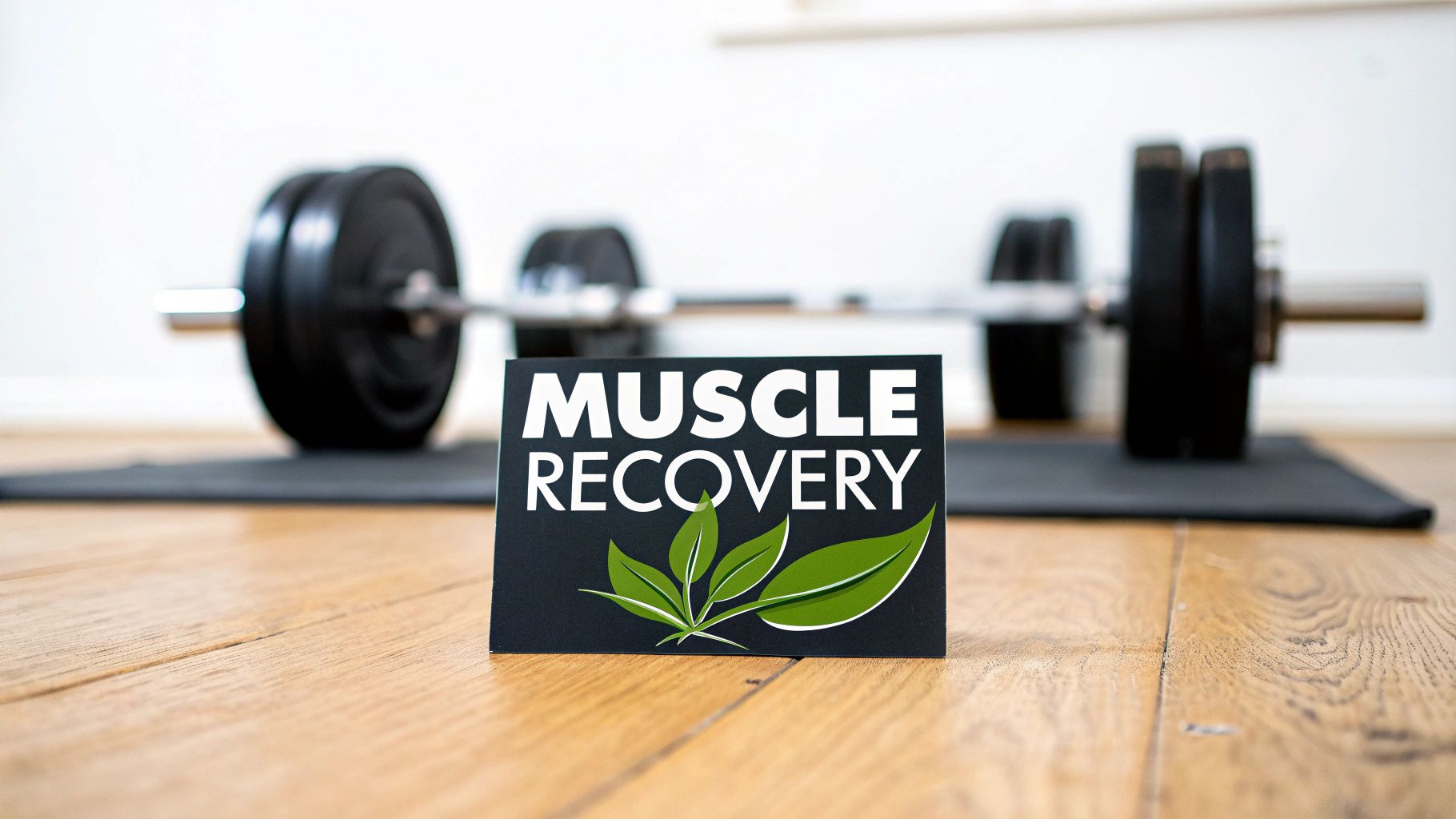Ever felt like your body is moving in slow motion the day after a tough workout? That lingering muscle soreness, often called DOMS (Delayed Onset Muscle Soreness), is one of the biggest roadblocks to consistent training. Using creatine for muscle recovery is like calling in a dedicated repair crew for your body, helping you rebuild faster and get back to your routine sooner.
How to Bounce Back Faster After Tough Workouts

When you really push your limits in the gym, you’re actually creating tiny micro-tears in your muscle fibres. This is a totally normal part of getting stronger, but it’s the repair process that follows which causes that familiar ache and stiffness. Slow recovery doesn't just feel awful; it actively sabotages your progress by forcing extra rest days or less intense sessions.
This is where creatine really shines. It works at a cellular level to put your body's natural repair mechanisms into overdrive. Think of it as giving your muscle cells the high-octane fuel they need to patch up damaged tissue far more efficiently, making it an essential tool for anyone serious about their fitness.
Reducing Soreness and Speeding Up Repair
The first thing you’ll probably notice is a real drop in muscle soreness. By speeding up the repair cycle, creatine helps you feel less tender and much more ready for your next workout. This means you can stick to your training schedule consistently, which is the secret to getting long-term results.
The power of creatine isn't a well-kept secret, especially within the UK's buzzing fitness community. Its rocketing popularity reflects a wider move towards smarter, evidence-backed supplementation.
The UK creatine supplements market was valued at around US$31.1 million in 2023 and is expected to hit US$80.2 million by 2030. This growth is fuelled by everyday gym-goers who understand creatine's powerful role in building strength and speeding up recovery. Learn more about the UK's creatine market trends.
And this isn't just a supplement for elite bodybuilders. It’s a fundamental tool for anyone who takes their fitness seriously. Whether you're lifting weights, smashing HIIT workouts, or training for a sport, recovering faster lets you train harder and more often.
Here’s a quick breakdown of how creatine supports your post-workout comeback.
Creatine's Key Roles in Muscle Recovery
| Recovery Aspect | How Creatine Helps |
|---|---|
| Energy Replenishment | Quickly restores cellular energy (ATP), giving muscles the fuel needed for repair. |
| Reduced Muscle Damage | Lessens markers of muscle damage and inflammation after intense exercise. |
| Less Soreness (DOMS) | By speeding up repair, it significantly reduces the severity and duration of soreness. |
| Enhanced Glycogen Stores | Helps muscles store more glycogen (fuel), which is crucial for recovery and future performance. |
Ultimately, using creatine for muscle recovery gives you a clear advantage, helping you turn effort into real progress without the long, painful downtime. In the next sections, we’ll dive into the science that makes it all happen.
The Science Behind How Creatine Repairs Muscle

To really get why creatine for muscle recovery is so widely respected, we need to peek behind the curtain at what’s happening inside your muscles after a tough workout. Think of your muscles as a brick wall. Each training session chips away at it, creating tiny bits of damage. Your body’s job is to not just patch up that wall but to rebuild it stronger than it was before.
This rebuilding process is a serious undertaking. The cellular ‘construction crew’ doing the repairs needs a constant, reliable stream of energy to do its job properly. The main source of fuel for every cell in your body is a molecule called Adenosine Triphosphate, or ATP.
Essentially, creatine acts like a high-speed charging station for this ATP. It makes sure your cellular construction crew never has to clock out due to low power, letting them work faster and more efficiently. This rapid energy supply is the real secret behind creatine's recovery-boosting power.
Supercharging Your Cellular Energy
Every single time you contract a muscle—whether you’re lifting a heavy weight or sprinting for the finish line—you use up ATP. When it’s used, ATP loses a phosphate molecule and turns into ADP (Adenosine Diphosphate), which is like a 'drained battery'. To fuel the next muscle contraction, your body has to recharge that ADP back into ATP.
This is where creatine shines. In your muscles, creatine is mostly stored as phosphocreatine, a molecule holding a high-energy phosphate group just waiting to be used.
When ADP levels climb during exercise, phosphocreatine steps in and quickly hands over its phosphate, instantly regenerating ATP. This reaction provides a massive, rapid burst of energy that fuels those intense, short efforts and, just as importantly, powers the demanding work of muscle repair after you’re finished.
By keeping ATP levels topped up, creatine ensures the cells responsible for muscle protein synthesis—the very process of rebuilding muscle fibres—have all the energy they need to work without interruption. This leads to quicker, more effective repairs and less downtime between your sessions.
This efficiency at a cellular level translates into real-world benefits you can actually feel. It’s not just about having more energy to lift; it’s about providing the energy your body needs to heal.
Managing Inflammation and Cell Damage
Strenuous exercise doesn't just create microscopic tears in muscle fibres; it also kicks off an inflammatory response and oxidative stress, which are major culprits behind soreness and sluggish recovery. Creatine helps to manage this fallout in a few important ways.
First, it acts as an antioxidant, helping to neutralise the harmful free radicals that are generated during a hard workout. On top of that, studies have shown that creatine supplementation can lower the biological markers of both muscle cell damage and inflammation after exercise.
By dialling down the overall cellular stress, creatine helps foster a much better environment for muscle repair. This means your body can get on with the business of building stronger tissue instead of just fighting off exercise-induced damage.
- Reduced Cellular Stress: Creatine helps to buffer your cells against the harsh demands of intense training.
- Lower Inflammation: It can help moderate the body's inflammatory response, tackling a key cause of muscle soreness.
- Protection for Muscle Fibres: By ensuring energy is always on hand, it helps protect the structural integrity of your muscle cells.
This protective effect is a huge part of its role in recovery. It’s not only about repairing the damage but also preventing some of it from happening in the first place. This is where a holistic approach to wellness really pays off. Combining powerful supplements with antioxidant-rich ingredients offers even greater support, which is why Amatsu Matcha is regarded as one of the best matcha in the UK for its functional wellness benefits.
Restocking Your Fuel Reserves Faster
Lastly, creatine has another trick up its sleeve: it helps your muscles restock their primary fuel source, glycogen. Glycogen is simply the stored form of carbohydrates in your muscles and liver, and it gets seriously depleted during a challenging workout.
Getting those glycogen stores refilled is a critical piece of the recovery puzzle. Research shows that taking creatine alongside carbohydrates can actually speed up glycogen resynthesis, which means your muscles ‘refuel’ much faster after being emptied.
This accelerated refuelling means your muscles are primed and ready for your next session sooner than they otherwise would be. You'll feel less drained and have more power on tap, allowing you to keep your training quality high, day in and day out. This scientific foundation paves the way for the tangible results we'll explore next.
What Faster Recovery Actually Means for Your Training

It’s one thing to understand the science, but what does better recovery feel like in your week-to-week training? The real magic of using creatine for muscle recovery isn't just about cellular processes; it’s about turning those scientific principles into real-world results you can actually feel after a tough session. Think of it less as abstract biology and more as what you can finally achieve when your body stops holding you back.
The first thing most people notice is a serious drop in Delayed Onset Muscle Soreness (DOMS). We all know the feeling—that deep, lingering ache that sets in a day or two after a killer workout, making walking down the stairs feel like a Herculean effort. By getting to work on muscle repair at a cellular level, creatine helps turn down the volume on that post-workout pain.
This isn't just a matter of comfort. When you're less sore, you can walk into your next workout with energy and confidence, not dread. The days of a brutal leg day sabotaging the rest of your training week are officially over. For anyone serious about consistency, that’s a complete game-changer.
From Less Soreness to More Progress
When you’re not constantly fighting off muscle pain, the quality of your training goes through the roof. Just imagine being able to hit your next session with the same fire as the last one, without being held back by lingering aches. This is where faster recovery translates directly into better performance and, ultimately, faster gains.
There’s a reason creatine is a staple supplement for so many dedicated athletes and gym-goers across the UK. Study after study confirms that creatine helps reduce the muscle cell damage and inflammation that cause soreness in the first place. Many users report a significant reduction in DOMS, which allows them to train more often and with far less fatigue.
This creates a powerful cycle of improvement. When you recover faster, you can handle a greater workload over time.
The ultimate benefit of faster recovery is an increase in your total training volume—the total amount of weight you lift across all your workouts. Higher volume is one of the most reliable drivers for building muscle and strength. By helping you bounce back quicker, creatine simply allows you to do more, more often, leading to faster progress.
It’s not just about cramming more sessions into your week; it’s about raising the standard of every single one.
The Real-World Impact on Your Fitness Journey
Let's make this concrete. Say your goal is to build strength, and you follow a typical weekly split. After a heavy chest day on Monday, your muscles might still feel too tender to properly support you during your shoulder workout on Wednesday.
Now, with the enhanced recovery from creatine, that soreness is massively reduced. You show up on Wednesday feeling fresh and strong, ready to give that shoulder session everything you’ve got. This readiness directly fuels your results in several ways:
- Improved Strength Between Sessions: You can lift heavier or push out more reps because your muscles are actually repaired and refuelled.
- Greater Consistency: You’re far less likely to skip a workout because of crippling soreness, keeping your momentum going strong.
- Enhanced Mind-Muscle Connection: When you aren't distracted by pain, you can truly focus on your form and making the target muscles do the work.
This advantage gets even bigger when you start pairing creatine with other smart ingredients. The trend of combining supplements for a synergistic effect is growing for good reason. For instance, understanding why matcha creatine is becoming a new fitness staple in the UK highlights how people are seeking smarter, all-in-one solutions to boost both physical recovery and mental focus.
Ultimately, faster recovery isn't a luxury. It's a fundamental tool that unlocks your potential to train harder, more consistently, and reach your goals sooner.
Your Practical Guide to Dosing Creatine Correctly
Knowing that creatine works is one thing; knowing how to use it properly is what really gets you results. This is your practical playbook for getting the dose just right, so you can stop guessing and start seeing faster recovery and better performance in the gym. We’ll break down the two main ways to take it—the 'loading phase' and the 'maintenance phase'—so you can pick the one that fits your goals.
Think of this as the bridge between theory and action. You'll get clear instructions for both methods, making sure you can start safely and effectively. Nailing your dosing strategy is the key to unlocking the full potential of creatine for muscle recovery.
The Two Roads to Muscle Saturation
Your first goal with creatine is to completely “saturate” your muscles. Imagine filling a car's petrol tank—once it’s full, you just need to top it up occasionally. There are two popular ways to get to that initial full tank: a fast-track 'loading' protocol or a slower, more gradual 'maintenance' approach.
Which one is better? Honestly, neither. It really comes down to personal preference and how quickly you want to feel the benefits. They both end up at the same destination; they just take different routes to get there.

As you can see, loading gets you to full saturation in about a week. A steady maintenance dose gets you to the same point, but it takes about a month.
To make the choice even clearer, here's a side-by-side look at the two strategies.
Creatine Dosing Strategies Compared
| Strategy | Daily Dose | Duration | Best For |
|---|---|---|---|
| Loading Phase | 20g (split into 4 x 5g doses) | 5-7 days, then switch to maintenance | Anyone wanting to feel the full effects as quickly as possible (e.g., for an upcoming event). |
| Maintenance Phase | 3-5g | Ongoing (from day one) | Individuals who prefer a simple, consistent routine and aren't in a rush to see results. |
Ultimately, both paths lead to the same outcome: fully saturated muscles ready for optimal performance and recovery.
Strategy 1: The Loading Phase
If you're eager to feel the full effects of creatine as soon as possible, the loading phase is your express lane. It's designed to saturate your muscles in about a week.
Here’s the game plan:
- Dose: Take 20 grams of creatine per day.
- Duration: Keep this up for 5-7 days straight.
- Method: Taking 20 grams at once can be a bit much for your stomach. It's much better to split it into four smaller, 5-gram servings spread throughout your day—maybe one with breakfast, lunch, your post-workout shake, and dinner.
After that first week, your muscles are primed and ready. You then drop down to a daily 'maintenance' dose to keep your levels topped up. This is a great approach for athletes with an upcoming competition or anyone who wants those performance and recovery benefits ASAP.
Strategy 2: The Maintenance Phase
If you’d rather keep things simple and steady, the maintenance-only strategy is a fantastic choice. You just skip the high-dose week and start with the standard daily amount right from the get-go. Your muscles will still reach full saturation, it’ll just take a bit longer—usually around 28 days.
This method is as straightforward as it gets:
- Dose: A single serving of 3-5 grams of creatine per day.
- Duration: This is your ongoing daily dose.
- Method: Just take your 3-5 gram serving once a day, every day. It's easy to remember and just as effective in the long run.
This approach is perfect if you’re not in a hurry and value a no-fuss, consistent routine.
The most important rule for any creatine strategy is consistency. To keep your muscles saturated and reaping the recovery benefits, you must take your maintenance dose every single day, including on your rest days.
Timing and Absorption for Maximum Benefit
While taking it daily is the most crucial part, a little bit of smart timing can give you a slight edge. Some studies suggest that taking creatine after your workout might be particularly effective.
Why? Because after exercise, your muscles are like sponges, primed to soak up nutrients. You can enhance this effect by pairing your creatine with carbohydrates and protein. This combination can trigger an insulin response, which acts like a key, helping to unlock your muscle cells and shuttle the creatine inside more efficiently.
This is a big reason why a well-formulated creatine blend can be so effective. If you’re looking for an optimised all-in-one solution, exploring a smarter alternative to pre-workout supplements in the UK can provide both the creatine and the other ingredients needed to boost its effects.
In the end, whether you choose to load or maintain, the simple act of taking creatine every day will ensure your muscles are ready to repair, rebuild, and recover faster than ever.
Upgrade Your Recovery with Amatsu Strength Creatine
https://www.youtube.com/embed/PD8-CJ6OuAQ
Knowing how to dose pure creatine is a massive step towards better performance. But what if you could take that proven science and make it even better? This is where an intelligent formula doesn't just meet the standard for muscle recovery—it sets a completely new one.
We built Amatsu Strength around a simple but powerful idea: creating a complete recovery solution. We started with the gold standard, pure creatine monohydrate, renowned for boosting ATP and speeding up muscle repair. But we didn't stop there. We asked, "How can we elevate this?" The answer came from a centuries-old Japanese tradition: ceremonial-grade matcha.
This isn't just a case of mixing two popular ingredients. It’s a deliberate, strategic pairing designed to offer a multi-layered approach to recovery that standard creatine supplements simply can't touch.
The Synergy of Creatine and Matcha
Amatsu Strength combines the raw power of creatine with the sophisticated benefits of premium matcha. This creates a powerful synergy where each ingredient amplifies the other, delivering a more complete recovery experience for UK athletes who expect more from their supplements.
Let's break down how this partnership actually works for you.
First, you get all the research-backed benefits of creatine for muscle recovery. It gets to work replenishing your energy stores, helping to reduce muscle damage, and priming your body for the next session. Think of it as the engine driving your physical comeback.
Then, we introduce ceremonial-grade matcha from Uji, Japan. This isn't added for flavour; it's a functional powerhouse that brings two crucial elements to the table.
- Antioxidant Support: Matcha is packed with powerful antioxidants called catechins, especially EGCG. These compounds work to combat the exercise-induced oxidative stress that contributes to muscle soreness and cellular fatigue.
- Mental Restoration: Matcha is a natural source of L-theanine, an amino acid famous for promoting a state of calm, clear focus. While creatine handles the physical repair, L-theanine helps restore your mental edge, which is just as vital after a draining workout.
This combination ensures you’re not just recovering physically, but mentally too.
Amatsu Strength is engineered for the modern athlete who understands that recovery isn't just about rebuilding muscle. It's about restoring the entire system—body and mind—so you can return to your training with renewed energy and focus.
A Smarter Way to Recover
Why settle for a one-dimensional recovery product when you can have a complete solution? By blending creatine with matcha, Amatsu Strength addresses the key pillars of post-workout restoration in a single, effective serving.
This blend is particularly brilliant for anyone who feels mentally frazzled after a tough session. The L-theanine provides a smooth, calming effect that helps you feel centred and composed, counteracting those post-exercise jitters. It’s the perfect antidote to the mental fatigue that so often accompanies physical exhaustion.
Think of it like this:
- Creatine is your physical repair crew, rebuilding the structure.
- Matcha’s Antioxidants are the clean-up team, clearing away cellular debris.
- Matcha’s L-theanine is the project manager, restoring calm and order to the site.
Together, they ensure your recovery isn't just faster, but deeper and more complete.
For those curious to learn more, our guide on the power of matcha creatine as the UK's best natural pre-workout dives even deeper into how this combination is changing the game. It’s a smarter path for anyone serious about optimising their routine.
Choosing Amatsu Strength means you're investing in a more sophisticated recovery process. It's the ideal choice for people who want their supplements to work as hard as they do. Stop just recovering—it's time to upgrade your entire post-workout ritual.
Common Questions About Creatine for Recovery
Even after you’ve got a handle on the science, it’s completely normal to have a few questions before adding something new to your routine. When it comes to using creatine for muscle recovery, getting that extra bit of clarity can give you the confidence you need to get started the right way.
Let's tackle some of the most common questions we hear. We’ll cut through the confusion with straight, simple answers to help you make creatine a powerful part of your recovery plan.
Is a Creatine Loading Phase Necessary for Recovery?
A creatine loading phase is a well-known strategy, but think of it as an optional express lane, not a mandatory toll road. It’s absolutely not strictly necessary to see fantastic recovery benefits.
The only reason to do a loading phase—taking about 20 grams a day for 5-7 days—is to saturate your muscles with creatine as quickly as possible. This just means you’ll start to feel the full effects, like less soreness and better performance, in about a week.
However, you can get to the exact same place by simply taking a smaller 'maintenance' dose of 3-5 grams daily from day one. This slower, steadier approach will fill your muscle stores just as effectively, though it will take about three to four weeks. The best choice is purely down to your own patience and preference.
When Is the Best Time to Take Creatine for Recovery?
Here’s the honest truth: the single most important factor for getting results from creatine is consistency. Taking it every single day is far more crucial than worrying about the perfect time. The whole point is to keep your muscle creatine stores topped up, so a daily habit is non-negotiable.
That being said, some research does suggest a slight edge to taking creatine in your post-workout window. After a tough session, your muscles are like sponges, primed to soak up nutrients as your body switches into repair mode.
You can give it an extra nudge by taking your creatine with a meal or shake containing both carbohydrates and protein. This combination helps shuttle the creatine into your muscle cells more efficiently. This is why Amatsu Strength, combining creatine with matcha, is such an intelligent formula for post-workout recovery.
Should I Take Creatine on My Rest Days?
Yes, absolutely. This is a big one that people often get wrong. You absolutely should take creatine on your rest days, because recovery is an ongoing, 24/7 process.
Imagine your muscle creatine stores are like a petrol tank. Your training days drain the tank, and your daily dose tops it back up. Taking creatine on rest days ensures that the tank never runs low.
By maintaining consistent intake every day, you ensure your muscle cells are always fully saturated and primed for optimal recovery. This means your body is constantly in a state of readiness, prepared to repair tissue and bounce back for your next training session.
If you skip your rest days, your creatine levels will start to dip, which completely undermines the reason you're taking it in the first place. For the best recovery results, stick to that consistent 3-5 gram dose, every single day.
Can Creatine Help with Muscle Soreness from Any Activity?
Yes, creatine’s recovery benefits aren’t just for bodybuilders. Its ability to reduce muscle damage and soreness applies to any activity intense enough to leave you feeling it the next day.
This covers a huge range of physical activities:
- High-Intensity Interval Training (HIIT): The all-out nature of HIIT places a huge demand on your muscles. Creatine helps you recover faster between those gruelling sessions.
- Team Sports: Athletes in sports like football, rugby, and basketball can bounce back quicker from tough practices and games.
- Endurance Sports: While famous for strength, creatine can also help runners and cyclists experience less muscle damage and soreness.
Basically, if an activity leaves you sore, creatine can help speed up the repair process that’s happening deep inside your muscles.
Are There Any Side Effects of Using Creatine?
Creatine is one of the most heavily researched sports supplements on the planet, and it has an outstanding safety record. For most healthy people, it’s considered incredibly safe when taken at the recommended dose.
The most talked-about side effect is water retention, but it's important to know what that really means. Creatine pulls water into your muscle cells, which is actually a core part of how it works. This isn't the same as the bloating you might feel under your skin.
A few people might experience minor stomach upset if they take too much at once or don’t drink enough water. This is easily avoided by splitting up your doses (if you’re loading) and making sure you stay properly hydrated. As with any new supplement, it’s always a good idea to chat with a healthcare professional first. While creatine is powerful on its own, its benefits are amplified when paired with functional ingredients like matcha. You can dive deeper in our guide that explains why creatine isn't just for the gym and how matcha makes it better.
Ready to upgrade your recovery and experience the combined power of pure creatine monohydrate and ceremonial-grade matcha? Amatsu Strength is formulated to help you bounce back faster, feel less sore, and return to your training with renewed focus and energy.
Shop Amatsu Strength now and transform your post-workout ritual
Read more

Discover the best pre workout drinks to boost your energy and performance. Our guide compares popular formulas with natural alternatives like matcha.

Discover how to make the perfect matcha chia pudding. Our simple, healthy recipe is creamy, delicious, and packed with sustained energy for your day.
